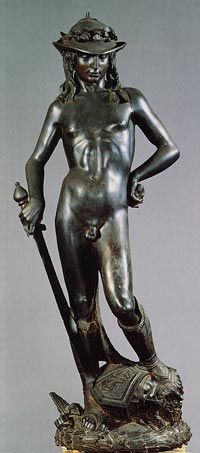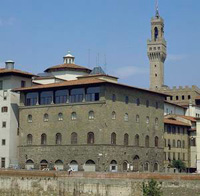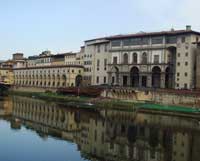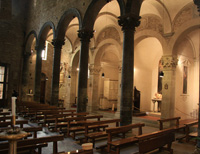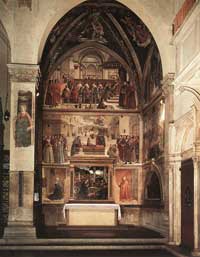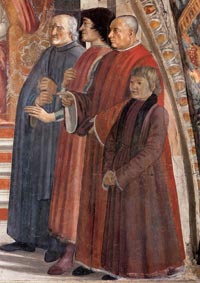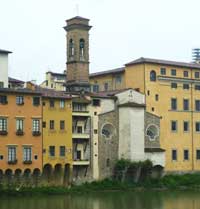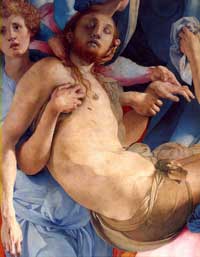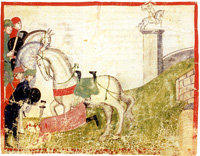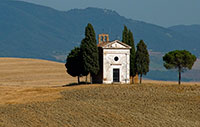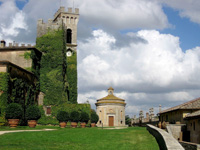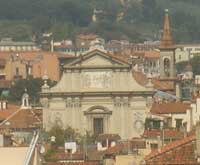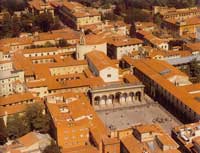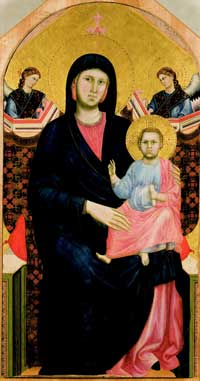Piazzale degli Uffizi |
|
Walking in Tuscany | Florence | A Walk Around the Uffizi Gallery |
| The Uffizi Gallery contains some of the most important and greatest art collections in the world. It is also the world’s oldest museum. |
1 - Badia Fiorentina |
||
From Piazzale degli Uffizi, walk towards Palazzo Vecchio, making sure you walk behind the statue of Hercules and Cacus by Baccio Bandinelli, up the seven or eight steps skirting the façade of the palace itself. If you look closely at the flattish stone almost on the corner of the palace about four courses up, you cannot fail to note the rather roughly carved face of a man. Legend has it that Michelangelo, who frequently crossed this square on his way to and from home, was often importuned by a local lunatic. One day his patience ran out, so while he pretended to listen to the lunatic as he leant against the wall of the palace, he amused himself by carving the man's likeness on the stone behind his back. Ever since that day, this face has been known to Florentines as L'Importuno. Carrying on past the main door to the palace, you will reach the Fountain of Neptune. Head diagonally to your right across Piazza della Signoria, walking past the equestrian statue of Grand Duke Cosimo I. Take Via de' Magazzini out of the northeast corner of the square. The street ends in a small square. On the left you can see the façade of the chapel of San Martino dei Buonuomini, containing 15th century frescoes showing the good works performed by the voluntary order whose chapel this was (incidentally, it takes the place of the earlier church of San Martino in which Dante was married to Gemma Donati). On the right, an archway leads into one of the former cloisters of the Badia Fiorentina, or "Florentine Abbey," affording a marvellous view of the bell tower and of the original façade built by Arnolfo di Cambio, the architect also responsible for the Duomo ( Sta. Maria del Fiore ) and Palazzo Vecchio. Back in the square, the tower next to the arch, on the corner of Via Dante Alighieri, was Florence's first "town hall", where the city fathers, or priori, met before Palazzo Vecchio was built. Turn right into Via Dante Alighieri, noting Dante's house on your left. The entrance to the Badia Fiorentina is a little way down on your right. As well as the church itself, you shouldn't miss the small cloister known as the Chiostro degli Aranci. Chiostro degli Aranci nella Badia Fiorentina, Via Dante Alighieri. Open 9-11.45am, 4.30-6pm. Admission: free. |
||
|
||
2 - Church of San Remigio |
||
On emerging from the Badia, turn left up Via del Proconsolo, remembering to look at the outline on the street paving showing where the foundations of an ancient Roman tower in the city walls were discovered during road works some years ago (the street marks the eastern limit of the Roman colony of Florentia). A little further up the street, you will come to a new building on the corner of Via del Proconsolo and Via Dante Alighieri. When the building was erected, it was decided to leave the remains of the Roman city wall, including a guard tower, on view through a glass floor. The remains can readily be seen by looking through the window from the street. Backtrack a little, cross Via del Proconsolo, and head down Via Ghibellina straight in front of you. |
||
Passing the north wall of the Bargell, a stout medieval fortress formerly home to the Capitano del Popolo and now the city's foremost sculpture museum, take the first road on the right, Via dell'Acqua, then the secondo on the left, Via delle Burella. You're in the heart of medieval Florence here, with most of the houses going back at least 700 years. The burella in question were the substructures of the amphitheatre, which lay outside the town in Roman times. When you come to Piazza San Simone at the end of the street, you may want to stop for an ice cream at Vivoli, on your left - reputedly the best ice cream in town. Now turn right down Via Torta, which becomes Via Bentaccordi after crossing Via dell'Anguillara, (notice the plaque on the corner house marking Michelangelo's first Florentine residence), then Piazza de' Peruzzi after crossing Borgo dei Greci. You'll have noticed the pronounced curvature of the three streets. They are in fact built over the amphitheatre's outer perimeter, and when you get to Piazza de' Peruzzi, you can see some of the ancient Roman masonry in the artisans' workshops on your left. Across from the workshops, a fuel merchant's shop is built into the remains of the loggia of the Peruzzi, a family of powerful Florentine bankers in the 14th century who were bankrupted after rashly lending money to both sides in the 100 years war. |
||
3 - Church of Santo Stefano al Ponte |
||
Come out of San Remigio and turn left down Via San Remigio, which leads into Via dei Neri. Turn right, then second left down Via del Castello di Altafronte, named after the castle that marked the southeast corner fortification of Florence's early medieval walls. Carry on right down to the river Arno, then cross over to the wall overlooking the river. On your right you'll see the Museo di Storia della Scienza, or Science Museum, housed in the medieval Palazzo Castellani, built in turn on the site of the Castello di Altafronte. It houses many splendid artefacts, including Galileo's original telescopes. Now saunter right along the Lungarno river bank until you get to the Uffizi, after which you will enter a gallery with arches. This is the famous Corridoio Vasariano, a suspended corridor built by Vasari in the 16th century to link the two Medici residences of Palazzo Vecchio and Palazzo Pitti, allowing the ducal family to move from one residence to the other without having to brush shoulders with the hoi polloi. (Nearby, in the Via de' Benci 6, is the Museo Horne. The museum building, the Palazzo Corsi-Alberti (1489), is worth more than a glance even if you're not going into the museum. The 15th century merchant's city home offers a rich look at Renaissance life in all of its smaller, more domestic, details). A little way down, you will see a junction of three roads on your left. Cross over the main road. On your right, by a restaurant called La Buca dell'Orafo (which serves excellent Florentine steak), a covered road runs back to the Uffizi - make a mental note to come back here for a stroll after dark. But for now, head up the lane in front of you called Vicolo Marzio. This will lead you into a square called Piazza Santo Stefano. The church on your right, with the remains of a "particoloured" Romanesque marble façade set in a later mannerist construction, is Santo Stefano al Ponte ("St. Stephen by the Bridge", the bridge in question being, of course, the Ponte Vecchio. It is currently used for exhibitions and concerts, while the former rectory houses the Diocesan Museum, a collection of works of art from country churches in the area around Florence, including an Angel by Giotto. |
|
|
|
||
4 - Church of Santi Apostoli |
||
Leave Santo Stefano by the main door and walk straight ahead, down the alleyway called Vicolo di Santo Stefano that leads west out of the square to Via Por Santa Maria . The street is named after the city's southern gate (or Porta of St. Mary) that stood here in Roman and early medieval times, when the Ponte Vecchio lay outside the city walls. This whole area was very badly damaged in World War II. Note the Torre degli Amidei almost directly opposite you, with two lion's heads built into its façade, one of which dates back to Etruscan times. Turn right, then first left into Borgo Santi Apostoli . Strolling down this wonderful medieval street you will come to the Palazzo Acciauoli at number 9. This was the city residence of the immensely powerful Acciauoli family, who were princes of Athens in the 14th century and who founded the Certosa or Carthusian monastery at Galluzzo on the outskirts of Florence. The palace has now been turned into flats and offices and cannot be visited. Further on, on the left, we come to Piazza del Limbo, which originally contained a cemetery for babies who died before they could receive baptism, hence the name. Lying below the current street level is the church of Santi Apostoli, probably the best preserved Romanesque church within the walls of Florence. During the flood of 1966 Santi Apostoli was completely under water. Many of the interior such as the frescoes were damaged beyond repair and others are still being restored. The Chiesa dei Santi Apostoli was traditionally founded by Charlemagne, although this is perhaps a legend, merely suggesting that it's "very old", the rectory houses a sacred vessel containing chips of stone from the church of the Holy Sepulchre in Jerusalem. These were supposedly given to Pazzino de' Pazzi by Count Godfrey of Bouillon after Jerusalem fell to the first crusaders in 1099, to reward Pazzino for his bravery in being the first Christian knight over the walls of the besieged city. They have been used ever since to strike the spark that ignites the fuse under a mechanical dove in the Easter ceremony known as the Scoppio del Carro, or Explosion of the Cart. The dove, duly set alight, wings his way from the high altar in the cathedral, down a wire, to a cart packed full of fireworks standing outside on the pavement between the cathedral and the baptistry. If the fireworks explode, that year's harvest will be abundant; if they don't, then a lean harvest is forecast for the year. Incidentally, the church also contains the tomb (by Bartolomeo Ammannati) of a Florentine noble and businessman called Bindo Altoviti, who was a major opponent of the Medici in the 16th century and whose portrait by Raphael hangs in the National Gallery of Art in Washington. The Palazzo Altoviti stands to the right of the church. As you come out of the church, notice the building on the north side of the square (across the street). Now sadly closed, it was used as public baths for the down-and-outs in the 19 the century, but in fact it stands on the exact site of the thermal baths in Roman times. A short stroll east down Borgo Santi Apostoli will bring you to Piazza Santa Trinita. |
||
|
||
5 - Basilica of Santa Trinita |
||
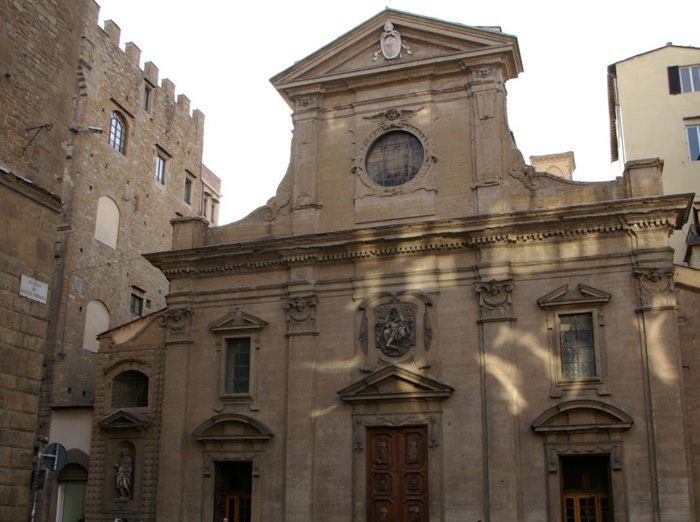 |
||
Basilica of Santa Trinita, Florence |
||
The first building on your right is the Palazzo Buondelmonti. Its original owners, the Cambi, sold it to the Buondelmonti family who had it completely rebuilt in the early 16 th century in pure Florentine Renaissance style. In 1820 a Swiss businessman by the name of Gian Pietro Vieusseux opened an establishment somewhat akin to a London literary club in the palace. The Gabinetto Vieusseux, as it became known, was to host some of the most famous names in Italian and European cultural history prior to its transfer to the Palazzo Strozzi (where it is still housed today). Its guests included Giacomo Leopardi, Alessandro Manzoni, Niccolò Tommaseo, Gino Capponi, Alexandre Dumas and Henri Beyle, better known as Stendhal. The second building on your right is the Palazzo Bartolini-Salimbeni, designed by Baccio d'Agnolo in the late 1520's, the only palace in Florence in the Roman Renaissance style. It became the Hotel du Nord in 1839 and many personalities of the time, including Moby Dick author Herman Melville, stayed there. Ironically, the Bartolini-Salimbeni family motto Per Non Dormire ("Not To Sleep") — not the best advertisement for a hotel — was never removed from the cross mullions in the windows. The column in the middle of the square is known as the Colonna della Giustizia. A monolithic oriental granite column from the Baths of Caracalla in Rome, it was given to Duke Cosimo I Medici by Pope Pius IV and erected here in 1560 to commemorate Cosimo's victory over anti-Medici Florentine exiles led by Baccio Valori and Filippo Strozzi at Montemurlo on 1 August 1537. The statue of Justice on top of the column is by Francesco del Tadda (1581). Two other palazzi are especially worth noting on the square before we cross over to the church. The first, on the left looking towards the bridge, is Palazzo Spini Feroni, which marked the southwest corner of Florence's early medieval walls. The building, begun in 1289, is now the headquarters of famous shoemakers Ferragamo, and you can visit the Ferragamo family museum in the basement. The palace originally continued right down to the river with the road passing under an arch built into it, but this was sadly demolished in a road-widening scheme in the early 19th century. Directly across the street is the Torre dei Gianfigliazzi, a wonderful example of a late medieval patrician residence rebuilt from 1270 on. Note the way the interior of the modern boutique on the ground floor has been ingeniously designed to keep well away from the precious remains of the original medieval decoration. And now for the Church of Santa Trinita itself. First, note the tonic accent in the word Trìnita falls not on the final " a " is in normal Italian but on the first " i ". This is because it comes from the Latin nominative case ( Trìnitas ) rather than from the accusative case ( Trinitàtem ) as it does in the rest of Italy. The basilica is a masterpiece of 14th century Gothic, the style in which the original Romanesque church was rebuilt when it was promoted to the rank of Vallombrosan abbey, although the later Mannerist façade was added by Bernardo Buontalenti in 1593. It was the original home of the Cimabue Crucifix and of Gentile da Fabriano's Adoration of the Magi, both of which you will be seeing in the Uffizi. And be sure not to miss the Cappella Sassetti, on the right next to the main chancel, with its superb frescoes showing the life of St. Francis by Domenico del Ghirlandaio. Created by Ghirlandaio in 1483, the decorative scheme of the Sassetti Chapel is Santa Trinita’s main attraction. Relating the Life of St Francis of Assisi, the artist painted a series of portraits of his contemporaries. In the depicted scenes may be discerned the Palazzo Vecchio, the Loggia della Signoria, the church of Santa Trinita, Lorenzo il Magnifico and (kneeling) the donors Francesco Sassetti and his wife, who lie in the magnificent tombs on either side of the altar. Notice in particular the fresco in the middle register of the back wall of the chapel, just above the altarpiece, showing Piazza Santa Trinita as it appeared in the late 15th century. It hasn't changed much, with both Palazzo Spini Feroni and the Torre dei Gianfigliazzi being eminently recognizable. The thing that has perhaps changed the most is the façade of the basilica itself. But if you turn back and look down the nave of the church, you can see on the inside of Buontalenti's façade the remains of the original Romanesque façade, just as it appears in Ghirlandaio's fresco. Before leaving, you should go through the door just to the right of the Sassetti chapel for a look at the sacristy, one of the very first pieces of architecture to be designed by Michelozzo di Bartolomeo Michelozzi, who was later to erect the Medici's first residence, now known as the Palazzo Medici-Riccardi. |
||
|
||
6 - Church of Santa Felicita |
||
When you come out of the church, turn right towards the river. Stop when you reach the middle of the bridge because this is absolutely the best place from which to photograph the Ponte Vecchio , seen at its best in the light of the setting sun in the late afternoon and early evening. The bridge you're standing on, the Ponte a Santa Trinita, is the third on the site. It was built by Bartolomeo Ammannati in the late 16th century, reportedly to a design by Michelangelo. Some have called it "the most beautiful bridge in Italy", and it's certainly one of the most graceful bridges anywhere in the world. Like all the other bridges in Florence apart from the Ponte Vecchio, it was blown up by the retreating German army in 1944; but unlike all the others, this masterpiece was rebuilt after the war as an exact replica "where it was and as it was" (" com'era e dov'era "). As many of its original stones as possible, and all four statues adorning it, were fished out of the Arno for the purpose and it was reopened in 1958. The statue of Spring, however, was missing its head, and it was felt to be something of a miracle when the head was found, still in the Arno, in 1961 and the reconstruction could finally be considered complete. As you look towards the Ponte Vecchio , you can see to your right the picturesque apse of the church of Sant'Jacopo Sopr'Arno hanging out over the river, and the massive structure of the former convent to its right, now a school, housed the Naval Ministry when Florence was briefly the capital of Italy in the late 19th century. Turning around and looking downstream for a moment, you will notice the British Consulate sporting the royal arms of England and, very possibly, the Union Jack a little way down the river on your right. The building housing the Consulate is the former Florence home the self-styled Duke and Duchess of Albany, in other words Bonnie Prince Charlie the "Young Pretender" and his wife Princess Louise of Stolberg-Gedern. Visitors the palace during Charles Stuart's time there included the celebrated poet Vittorio Alfieri, although this was more often than not in his capacity as the Duchess of Albany's secret lover! Almost directly opposite the British Consulate, the dark orange-coloured palace on the Arno's rive gauche housed, until the mid-80's, what was one of the most famous pensioni in Florence, the Pensione Bartolini. It was rechristened Bertolini by Henry James in Room With a View, and the view in question was of the façade of San Miniato al Monte, the white-and-green marble romanesque church above Piazzale Michelangelo. As you will find out below, movie director James Ivory considered Henry James' view a little too abstruse for the modern cinema-goer, so he chose to "relocate" to a pensione closer to the Uffizi and to identify the view with the cupola of Florence Cathedral. Further along on the same bank, the crenellated Palazzo Lanfredini has been home to the British Institute of Florence since 1917. Now carry on over the bridge, taking the first left into Borgo San Jacopo. Passing Bernardo Buontalenti's picturesque 16th century Fontana dello Sprone on the corner of this street and Via dello Sprone, walk down past the façade of the church of Sant'Jacopo — actually the façade of the demolished church of San Donato a Scopeto , re-erected here in the 16th century — and admire the numerous medieval towers on either side of the street. Borgo San Jacopo contains the greatest concentration of surviving medieval towers in Florence, and this, even after half the street was blown up by the retreating German army at the end of World War II. Borgo San Jacopo leads to the bottom end of the Ponte Vecchio . Notice how Vasari's Corridor creeps around a tower here rather than passing through it. The Mannelli family, who owned the tower, refused to allow Duke Cosimo to bully them into letting him drive his private corridor through their property, so Vasari was forced to put the corridor out on stilts around the tower just for this short stretch. After admiring the statue of Bacchus by Giambologna in the Rossi-Cerchi tower on the corner diagonally opposite, turn right into Via Guicciardini. Almost immediately, you will see a small square across the street with a column in it, and behind the column a church façade with Vasari's Corridor running in front of it. The square is Piazza Santa Felicita , and the column in the middle (patiently pieced together again after its destruction in World War II) commemorates St. Peter Martyr's endeavours to extirpate the Patarene Heresy in the 13th century. Passing under Vasari's Corridor, you now enter the church of Santa Felicita which, despite appearances (it was rebuilt in the 18th century), is one of the oldest centres of Christian worship in Florence. Again, note the tonic accent in the word Felìcita falls not on the final " a " is in normal Italian but on the first " i ". This is because it comes from the Latin nominative case ( Felìcitas ) rather than from the accusative case ( Felicitàtem ) as it does in the rest of Italy - sound familiar? Armed with sufficient € 1 coins to keep the illumination working, look to your right the moment you enter the church. The Cappella Capponi (architecture maybe by Brunelleschi) contains Pontormo's masterpiece, the Deposition, probably one of the greatest paintings in the world. Totally different, but not to be missed, is the former Chapter House, the only remnant of the medieval convent, with its frescoes by Niccolò di Pietro Gerini. And if you can successfully bribe the sacristan, you may even be lucky enough to visit the underground passages containingh a remnant of the original Roman Via Cassia, metres below the present-day street level. It was along this major consular road linking the Roman colony of Florentia to the capital, Rome, that Syrian merchants set up shop in the 4th century, outside the colony's walls and over a wooden bridge close to where the Ponte Vecchio stands today. They brought Christianity with them, and their community's cemetery lies under what is left of the cloister of Santa Felicita. Leave the church, cross back over the Ponte Vecchio, turn right along the river, passing the Hotel degli Orafi which James Ivory chose as"his" Pensione Bertolini in the film Room With a View, and when you get to the Uffizi, cross the road and go straight to the pre-booked ticket office, where your tickets will be waiting for you. |
||
| The Torre degli Amidei |
||
Coming down from the Ponte Vecchio, at the beginning of Por Santa Maria on the left side we can see the Torre degli Amidei. The Torre degli Amidei is a tower dating from the upper Middle Ages. Once located near the city's ancient walls, it belonged to the Amidei family. The Amidei were a prominent family in Florence and Tuscany and are best remembered for a particular event during the Guelf and Ghibelline conflicts. Not far from this tower, at the head of the Ponte Vecchio, on Easter morning 1216, members of the Amidei faction murdered Buondelmonte dei Buondelmonti after he broke his engagement with one of the female members of the family. In his Divine Commedy, Dante tells the tale of Buondelmonte de' Buondelmonti, and the tragic fate which befell the man in the vicinity of one of the best known symbols of Florence, the Ponte Vecchio. The murder is often given a political rather than personal motivation: the victim and his assassin were of opposing factions: the Buondelmonti supporting the Guelphs and the Papacy and the Amidei sustaining the cause of the Ghibellines and the Holy Roman Empire. Villani's Nuova Cronica | The Ponte Vecchio and the Buondelmonte murder |
||
|
The Uffizi Gallery |
||
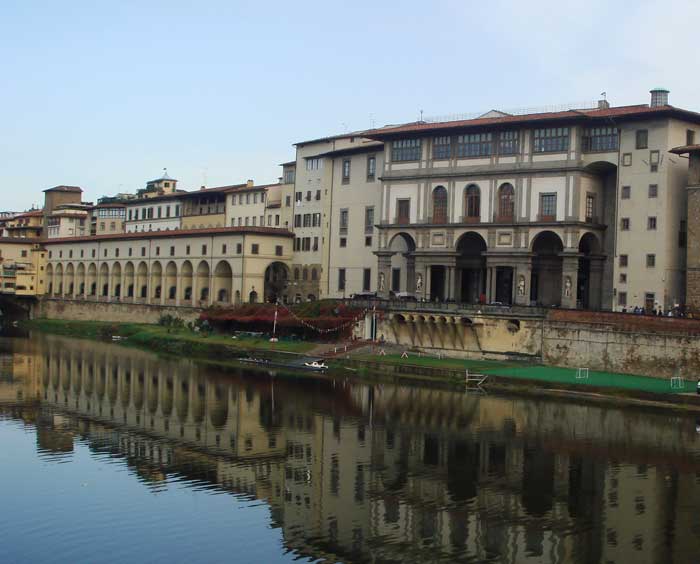 |
||
| The Vasari Corridor and the Uffizi Gallery |
||
The collection of works in the Uffizi Gallery cannot be compared to any other world collection and is probably the only one to have just masterpieces of exceptional value.
The Gallery is housed in the building built by Cosimo I of Medici and designed by Vasari in 1560. But the collection was started in 1574 when Cosimo's son, Francesco I, transformed the second floor of the Vasarian building into a place 'to walk in with paintings, sculptures and other precious things' and entrusted Buontalenti with the creation of a Tribune where art objects could be exhibited. Vasari, who died that same year, could hardly have imagined that inside that building, born to house the Magistracy, almost all the major painters (not just Florentine) whose biographies he had written in one of the most interesting documents on the history of art, Lives, would have been on show. It was based on an idea of Vasari, who had put the portrait of each artist with his biography, that Leopoldo de'Medici started the rich collection of artists' self-portraits. This kept on growing over the centuries with a further 250 self-portraits arriving in the 20th century, often gifts from the artists themselves. Like Chagall who went to Florence himself to hand over his portrait. To Leopoldo's love of collections we also owe the extraordinary miniatures collection which now has 1392 pieces and is second only to the one in the Victoria and Albert Museum in London. Without counting the vast archeological anthology along the stairs, the lobbies, in the three Corridors and organized in a particularly opulent way in the Niobe Hall. The complex also houses the important collection in the Drawings and Prints Room. But nowadays the Uffizi are mainly a great art gallery, starting from the 13th century with Cimabue, to reach Tiepolo, Canaletto and Guardi in the last hall. Here we find the Italian painting of the Tuscan Macchiaioli or of Carrà and Severini, the foreigners Ingres and Delacroix, but also Durer, Rubens, Rembrandt and where, above all you have the unbeatable Florentine and Italian Renaissance selection, just think of the 27 Botticelli including The Birth of Venus and the Springtime or the Doni Tondo by Michelangelo, the Annunciation by Leonardo Da Vinci. The process that led to the creation this rich heritage was not short and lasted several centuries, starting form the 17th century. The Gallery was often enriched by works collected over the years by the Medici in their villas and palaces: Ferdinando I had been given some Caravaggio as a gift, Cosimo II bought a series of Caravaggeschi, Don Lorenzo dei Medici, in his Petraia villa, mainly collected contemporary Florentine artists and many others were collectors during the 18th century managing to put together thousand of paintings: Cardinal Leopoldo, for example, owned about half the Venetian paintings on show in the Gallery today. The exceptional aspect of the Uffizi also lies in this surprising creation process: the continuing, really extraordinary, knowledgeable and, above all, passionate collecting of kings and young princes. And in this sense the Florence Uffizi certainly represent the greatest works conceived by the Medici offspring. In 1782, for the first time these works were organized into the Ancient Picture Room, but it was the reordering in 1919 that gave us a more organic arrangement. Art in Tuscany | Palazzo degli Uffizi and the Uffizi Gallery |
||
|
||||
|
||||
Podere Santa Pia |
Podere Santa Pia |
Madonna di Vitaleta Chapel, San Quirico d'Orcia |
||
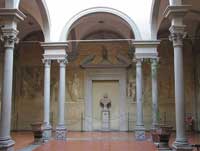 |
||||
Villa Celsa near Florence |
Piazza della Santissima Annunziata in Florence |
Choistro dello Scalzo, Florence |
||
The façade and the bell tower of San Marco in Florence |
Piazza della Santissima Annunziata in Florence |
Florence, Duomo |
||
The San Remigio di Firenze church was founded around the year 1000. It is dedicated to Saint Remigius. In the 13th century, the church was reconstructed to feature a triangle-shaped facade with hanging arches along the roof line. The interior still reflects the original Gothic architecture with ogive arches and octagonal columns along the three aisles. |
||||
Just a short distance from the Ponte Vecchio, on the left bank of the Arno is the Chiesa di Santa Felicita, probably the second oldest church in Florence after the church of San Lorenzo. The Santa Felicita is renown for the masterpiece of Mannerist painting exposed in one of its chapels, the Deposition by Jacopo Pontormo. The altarpiece that was painted in total isolation around 1525 is filled with unforgettable figures, that seem to be blown from glass, suspended in a painful, metaphysical silence pervaded by a timeless light. The frescoed Annunciation is also by Pontormo. Santa Felicita Church, Piazza di Santa Felicita, 50125 Firenze. Admission to the church is free. |
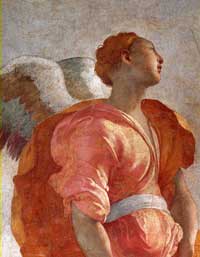 Jacopo Pontormo, Annunciation, detail, 1525-28, (fresco), Capponi Chapel, Santa Felicita, Florence |
|||
| Institute and Museum of the History of Science
| Galileo Galilei's scientific instruments are the big draw at the Museo di Storia della Scienza, but even without them, this would be one of the most interesting museums in Florence. Galileo's compass and his leather-bound telescope are in the two rooms dedicated to the heretical stargazer. Art continues to mingle with science in Room 7, devoted to armillary spheres and dominated by a model commissioned by Federico II in 1593. Most of the spheres have the earth placed at the centre of the universe, surrounded by seven spheres of the planets. The second floor has an eclectic mix of machines, mechanisms and models, including a 19th-century clock (pianola) that writes a sentence with a mechanical hand, and a selection of electromagnetic and electrostatic instruments (Room 14). The display of amputation implements and models of fetuses adorning the walls are rather grisly. For information about events in Florence and Tuscany to commemorate the 400-year anniversary of Galileo's discovery. |
||||
| The Chiesa Santo Stefano al Ponte is a church in Florence. The church was originally constructed in the 11th and 12th century in a Romanesque style with a polychrome marble facade. The annexed Diocesan Museum houses a panel with a Madonna by Giotto and exhibits works of art taken from other churches in town and in the territory of the diocese of Florence. The Church of Santo Stefano al Ponte Vecchio was badly damaged during the second world war, and again by the 1966 flood. It has a main entrance, which has a two-colored stone molding, dating back to late 13th century. The interior is rectangular, and originally had three aisles, which were merged into a single nave by F. Tacca between 1649 and 1655. The roof has exposed trellisbeams that are at two different elevations. The church has now been deconsecrated, and hosts the Orchestra Regionale Toscana. Hosted in a beautiful Romanesque church (Church of Santo Stefano al Ponte), first attested documentary in 1116, Museo di Santo Stefano Al Ponte boasts a number of important religious artifacts, from which the most notable is a panel with a Madonna and Christ Child enthroned with angels by Giotto. Museo di Santo Stefano Al Ponte was first opened in 1983 to display a number of works from the Florentine churches in the surrounding regions. The museum was severely damaged during a bombing in 1993, which destroyed the ceiling and some very important art works. The museum was reopened in 1995, and it can now be visited only on Friday afternoons. Museo Horne | The 15th-century Palazzo Corsi-Alberti was purchased in the 1800s by English architect and art historian Herbert Percy Horne, who restored it to its Renaissance splendour. When he died in 1916, he left his palazzo and vast collection to the state. Objects range from ceramics and Florentine coins to a coffee grinder and a pair of spectacles. Upstairs is a damaged wooden panel from a triptych attributed to Masaccio. Also here is an Exorcism by the Maestro di San Severino and, the pride of the collection, a gold-black Santo Stefano by Giotto. Herbert Percy Horne, the museum's English founder, came to Florence in the late 19th century and was a self-fashioned art critic and collector, often butting heads with rival Bernard Berenson. He bought the dilapidated Palazzo Corsi-Alberti in 1911 and lovingly restored it and filled it with rare examples of ceramics (including a 14th century wine jug), coins, early silverware and wooden chests done in exquisite marquetry designs. There are a number of paintings by the so-called "primitives" (Pietro Lorenzetti, Agnolo Gaddi, Bernardo Daddi and a St. Stephen by Giotto), many of whom gained important recognition in the art world thanks to Horne's work. Museo Horne, Via de' Benci 6, Florence open, Monday to Saturday, 9 a.m. to 1 p.m. |
||||
| Palazzo Altoviti or Visacci was built in 1538 by Bartolomeo Panciatichi who incorporated at least three old buildings, including the house of Rinaldo degli Albizi, rival of Cosimo the Elder. Towards the mid 16th century, senator Baccio Valori whose family had entered into possession of the Albizi building, entrusted Giovanni Caccini with enlarging the building and renovating the facade. Valori laid out the iconographic programme of the facade’s decoration, which he wanted adorned with fifteen herms of illustrious figures of Florentine culture. The personages portrayed include Marsilius Ficinus, Amerigo Vespucci, Leon Battista Alberti, Francesco Guicciardini, Dante, Petrarch and Boccaccio. These portraits were called "Visacci", that is to say ugly faces, hence the name of the building. The Visacci were described in 1604 by Baccio’s son. Valori, librarian of the Biblioteca Medicea Laurenziana and president of the Academy of Drawing Arts, made Palazzo Altoviti one of the propulsive centres of cultural life in Florence. Palazzo Altoviti, Borgo degli Albizi 18, Florence |
||||
1 | A Walk Around the Uffizi Gallery 2 | Quarter Duomo and Signoria Square 3 | Around Piazza della Repubblica 5 | San Niccolo Neighbourhood in Oltrarno |
||||

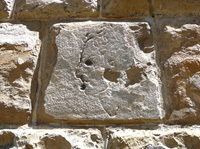
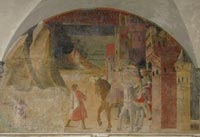 The Badia Fiorentina, frescoes by Nardo di Cione
The Badia Fiorentina, frescoes by Nardo di Cione